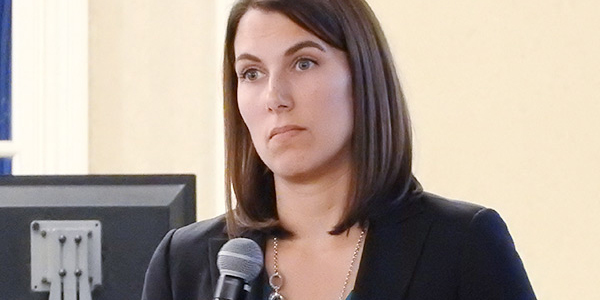PJM last week shared its initial response to FERC’s April 16 rehearing orders on the minimum offer price rule (MOPR), which required the RTO to make an additional compliance filing by June 1.
The commission rejected rehearing of its June 2018 order declaring PJM’s capacity market unjust and unreasonable (EL16-49-001, et al.) and virtually all of its December 2019 ruling spelling out the expanded MOPR (EL16-49-002, et al.) but provided clarification on several points. (See FERC: RGGI, Voluntary RECs Exempt from MOPR.)
Lisa Morelli, PJM director of capacity, demand response and compliance, gave the Markets and Reliability Committee a presentation Thursday highlighting where FERC’s directives diverged from PJM’s initial compliance filing in March. (See PJM Makes MOPR Compliance Filing.)
Morelli said PJM will share how it is addressing each issue cited by the commission in future meetings. “In many cases, we’re still working through the interpretation of these items in developing what our compliance approach is,” Morelli said.
State Subsidy Definition
FERC agreed with PJM that renewable energy credits (RECs) are not considered state subsidies if they are used and retired for voluntary obligations rather than for state-mandated renewable portfolio standards.
The commission also backed PJM’s position that fees paid by resources under the Regional Greenhouse Gas Initiative are not state subsidies but clarified that RGGI payments to specific generation units are subsidies and subject to MOPR.
Morelli said one of the biggest surprises in the ruling was the denial of rehearing requests seeking to exempt state default service procurements from the definition of a state subsidy, a ruling she said PJM will have to address in its new filing.
FERC’s directive can be read broadly to cover any resource that contracts to supply generation to a load-serving entity that won tranches of load in a default service auction, she said. But she said references to “specific winning resources” suggests “there are also more narrow readings that are reasonable, as well.”
Impacts to MOPR Floor Prices
PJM’s initial compliance filing based MOPR floor prices for energy efficiency on the verifiable level of savings. But FERC directed that the EE floor price be based on net cost of new entry (CONE) or — for existing resources — net avoidable-cost rate (ACR).
The net CONE and ACR must include the cost of measurement and verification, Morelli said, prompting PJM to examine whether further revisions may be needed to address the issue.
The commission also said net ACR should be based on resource-specific revenues rather than zonal averages, as PJM had suggested.
FERC also said PJM’s compliance filing should not contain any substantive changes to its existing MOPR rules; until the December order, MOPR applied only to new natural gas resources. Morelli said the order creates two different MOPR floor levels — one for new-entry natural gas and the expanded MOPR for state-subsidized resources.
New/Existing Capacity Resources
FERC clarified that only the cleared portion of a resource’s megawatts will be treated as an existing resource.
The commission denied a requested clarification that demand resources should be considered existing if they had previously cleared an auction regardless of the number of megawatts offered. The commission said demand resources increasing the number of megawatts they offer year to year must explain that the increase is not connected to additional construction costs or state subsidies that make the uprate possible.
Resources not subject to the Capacity Performance must-offer requirement, including demand response and intermittent renewables, will be treated as new resources if they seek to re-enter the capacity market after sitting out an auction.
Bilaterally procured capacity from a state-subsidized resource cannot serve as replacement capacity for unsubsidized capacity resources, the commission said, clarifying that public power self-supply entities cannot engage in voluntary, bilateral contracts with unaffiliated third parties without triggering the MOPR.
Morelli said PJM tried to balance FERC’s directive that public power is state-subsidized with not impeding normal commercial activity in contracting between public power and merchant entities. “We’re still evaluating this provision and whether it will indeed have an impact on our compliance filing.”
Stakeholder Responses
Tom Hyzinski of GT Power Group asked how PJM’s additional compliance filing could affect the capacity auction dates.
Morelli said the intention was to run the first auction about six and a half months after receiving FERC approval on its compliance filings. She said the auction has been set up as a “floating schedule” contingent upon receiving FERC approval, with PJM still anticipating that it could hold an auction by the end of the year.
Bruce Campbell, director of regulatory affairs for CPower, said that because FERC rejected rehearing requests to exempt EE from the MOPR, there needs to be a “fairly robust resource-specific offer methodology” established. Campbell asked PJM to give the process immediate attention recognizing that they will be new for staff and stakeholders.
“I think it’s incumbent on parties to really get a good understanding of how that will work before we push up against the deadline,” Campbell said.
PJM Independent Market Monitor Joe Bowring invited stakeholders concerned with the EE methodology to contact his office. “We’ll provide a template,” he said. “We’re committed to make it work efficiently.”
PJM will hold a stakeholder “listening session” regarding the FERC orders in a special meeting of the Market Implementation Committee on May 6 and a detailed session at the MIC’s regular meeting May 13. Rehearing requests are due to FERC by May 18, three days after the deadline for comments on PJM’s March compliance filing.
The RTO will also hold a final information session — tentatively scheduled for May 28, pending the agenda for the Markets and Reliability and Members committee meetings — before making its new compliance filing.



